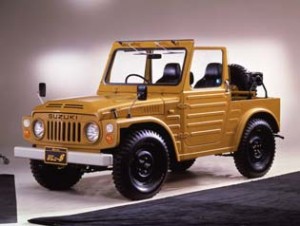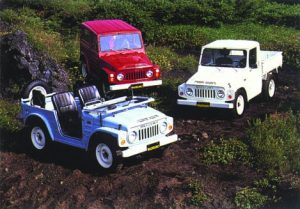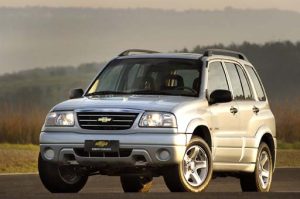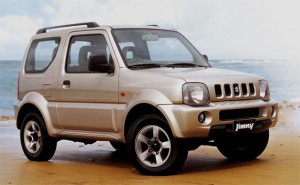THE BIG SUCCESS OF A SMALL 4X4
Suzuki celebrated in 2008 a triple anniversary: 40-year’s anniversary of launching their first 4×4 vehicle, 20-year’s of Vitara and 10-year’s of Grand Vitara. Over the past 40 years Suzuki has been producing an increasingly sophisticated range of ground breaking 4×4 vehicles for markets throughout the world and has clearly demonstrated its ability to design and continually develop a unique range of Sports Utility Vehicles.
 With development starting in 1968, the first Suzuki 4×4 lightweight vehicle became available in 1970 and was marketed with only three seats. In order to comply with limitations on the class’s external dimensions the spare tyre had to be fitted behind the front passenger‘s seat. It was a simple vehicle with zipped canvas doors and leaf springs to cope with big loads for the light and tiny 4×4 (it weighted just 600kg and had a wheelbase of 1930mm). A separate chassis allowed the use of lightweight body panels. The first LJ was powered by a new but equally small twin cylinder air-cooled two stroke 360cc engine turning out 25bhp and was marketed under it’s new name – Jimny. The first Suzuki 4×4 was also the first mass-production 4×4 in Japan’s domestic mini-car category.
With development starting in 1968, the first Suzuki 4×4 lightweight vehicle became available in 1970 and was marketed with only three seats. In order to comply with limitations on the class’s external dimensions the spare tyre had to be fitted behind the front passenger‘s seat. It was a simple vehicle with zipped canvas doors and leaf springs to cope with big loads for the light and tiny 4×4 (it weighted just 600kg and had a wheelbase of 1930mm). A separate chassis allowed the use of lightweight body panels. The first LJ was powered by a new but equally small twin cylinder air-cooled two stroke 360cc engine turning out 25bhp and was marketed under it’s new name – Jimny. The first Suzuki 4×4 was also the first mass-production 4×4 in Japan’s domestic mini-car category.
 The LJ10 achieved success in the domestic market but Suzuki knew that other countries, without Japan’s mini-car category, would need a bigger engine. Countries don’t come any bigger than Australia, so when the LJ50 was exported there in 1974, it had a 550cc three-cylinder, water-cooled two-stroke unit that gave better power. The spare wheel moved to the outside, on a hanger at the rear, allowing two rear passenger seats, both facing each other. Hard and soft-top versions were available in Australia, where the LJ50 soon gained a reputation as a fun go anywhere vehicle.
The LJ10 achieved success in the domestic market but Suzuki knew that other countries, without Japan’s mini-car category, would need a bigger engine. Countries don’t come any bigger than Australia, so when the LJ50 was exported there in 1974, it had a 550cc three-cylinder, water-cooled two-stroke unit that gave better power. The spare wheel moved to the outside, on a hanger at the rear, allowing two rear passenger seats, both facing each other. Hard and soft-top versions were available in Australia, where the LJ50 soon gained a reputation as a fun go anywhere vehicle.
 The development upmarket for what was originally a utility 4×4 continued with the last LJ model, the LJ80. Body changes were minimal, with larger front wheelarches and flared rear wheelarches to offer a more stylish design. The bonnet, still held down with two spring clips like on earlier LJs, was slightly raised to make room for the biggest change – a new engine. This was a four-cylinder, water-cooled 800cc four-stroke unit producing 41bhp. The LJ80 sold well in Australia, where it went on sale in 1978, but that was just the start. When the LJ80 was first exported to the Netherlands in 1978 followed by the rest of Europe it created and firmly established a whole new market sector for fun 4×4 recreational vehicles.
The development upmarket for what was originally a utility 4×4 continued with the last LJ model, the LJ80. Body changes were minimal, with larger front wheelarches and flared rear wheelarches to offer a more stylish design. The bonnet, still held down with two spring clips like on earlier LJs, was slightly raised to make room for the biggest change – a new engine. This was a four-cylinder, water-cooled 800cc four-stroke unit producing 41bhp. The LJ80 sold well in Australia, where it went on sale in 1978, but that was just the start. When the LJ80 was first exported to the Netherlands in 1978 followed by the rest of Europe it created and firmly established a whole new market sector for fun 4×4 recreational vehicles.
 In 1982 Suzuki continued to enjoy a developing level of success in the domestic market, but it was with the export of the SJ410 that the company really broke onto new markets. It was an all new design for a 4×4 vehicle that offered a new statement in fashionable styling. True to the utility heritage, it still featured leaf-spring suspension although this had been softened with gas dampers at the rear and improved approach and departure angles. Under the new bodywork, which featured a sloping grille, there was a new interior and a brand new engine, a four-cylinder 1000cc four-stroke delivering 45bhp. The separate chassis and small dimensions combined with a bigger engine to make the SJ410 a real giant-killer off-road, and it continued to expand further the leisure 4×4 market created by Suzuki.
In 1982 Suzuki continued to enjoy a developing level of success in the domestic market, but it was with the export of the SJ410 that the company really broke onto new markets. It was an all new design for a 4×4 vehicle that offered a new statement in fashionable styling. True to the utility heritage, it still featured leaf-spring suspension although this had been softened with gas dampers at the rear and improved approach and departure angles. Under the new bodywork, which featured a sloping grille, there was a new interior and a brand new engine, a four-cylinder 1000cc four-stroke delivering 45bhp. The separate chassis and small dimensions combined with a bigger engine to make the SJ410 a real giant-killer off-road, and it continued to expand further the leisure 4×4 market created by Suzuki.
 In 1986 Suzuki launched an upgraded SJ model, the SJ413 (Samurai) – selling in over 100 countries worldwide and assembly of some models everywhere from India to Spain as well as Japan. As the model name indicated, the engine was now a 1.3-litre four-cylinder unit producing 66bhp. This lightweight engine was adapted from the Suzuki Swift and featured a five-speed gearbox. Inside the comfort levels were significantly developed. An American car magazine concluded that if you wanted a rugged 4×4 for the minimum amount of money, then the SJ413/Samurai „was the only game in town“.
In 1986 Suzuki launched an upgraded SJ model, the SJ413 (Samurai) – selling in over 100 countries worldwide and assembly of some models everywhere from India to Spain as well as Japan. As the model name indicated, the engine was now a 1.3-litre four-cylinder unit producing 66bhp. This lightweight engine was adapted from the Suzuki Swift and featured a five-speed gearbox. Inside the comfort levels were significantly developed. An American car magazine concluded that if you wanted a rugged 4×4 for the minimum amount of money, then the SJ413/Samurai „was the only game in town“.
 In 1988 the Suzuki 4×4 family expanded with the launch of the all-new Vitara, a 3-door model that soon gained its own enthusiastic following. The new Vitara was complemented by a 1.6-litre lightweight alloy engine. It was a true 4×4 with separate steel chassis, five-speed gearbox, part-time four-wheel drive system and integrated two-speed transfer box. However, ride and comfort achieved new levels with the leaf springs of earlier models replaced by coil springs front and rear, standard power steering and an interior that was functional, but much more comfortable.
In 1988 the Suzuki 4×4 family expanded with the launch of the all-new Vitara, a 3-door model that soon gained its own enthusiastic following. The new Vitara was complemented by a 1.6-litre lightweight alloy engine. It was a true 4×4 with separate steel chassis, five-speed gearbox, part-time four-wheel drive system and integrated two-speed transfer box. However, ride and comfort achieved new levels with the leaf springs of earlier models replaced by coil springs front and rear, standard power steering and an interior that was functional, but much more comfortable.
 In 1991 the Vitara range expanded, literally, with the longer-wheelbase 5-door, 1.6-litre model. Width stayed the same but the wheelbase went up to 2480mm and the overall length similarly increased to 4030mm. By this time some models started to feature fuel injection to provide power of 80bhp and a catalytic converter to reduce emissions. The performance of the 5-door model developed further with the introduction of 16 valves and multi-point fuel injection, giving 95bhp. More legroom, more luggage capacity and the option of an automatic version helped reached new customers for the Vitara.
In 1991 the Vitara range expanded, literally, with the longer-wheelbase 5-door, 1.6-litre model. Width stayed the same but the wheelbase went up to 2480mm and the overall length similarly increased to 4030mm. By this time some models started to feature fuel injection to provide power of 80bhp and a catalytic converter to reduce emissions. The performance of the 5-door model developed further with the introduction of 16 valves and multi-point fuel injection, giving 95bhp. More legroom, more luggage capacity and the option of an automatic version helped reached new customers for the Vitara.
In 1995 the first V6 engine ever in a 4×4 vehicle brought a new sophistication to the 5-door Vitara. With 134bhp produced smoothly, aided by a 2.0-litre engine with 24 valves and four camshafts, this was the most powerful Vitara ever. To match the engine, the bodywork was revised with stylish, lower splash guards and flared arches accommodating optional wider alloy wheels. The interior was revised with higher specifications features such as dual airbags, electric windows and mirrors, central locking and ABS.
In 1996 Suzuki introduced a turbo-diesel engine and the following year offered an intercooled version. The 2.0-litre four-cylinder unit gave superb flexibility for off-road use and comfortable on-road driving, coupled with economical fuel consumption. Intercooling the unit gave 23% more horsepower and 29% more torque. Short wheelbase, long wheelbase, 1.6-litre, 2.0-litre, petrol, diesel, manual, automatic – the Vitara range was complete.
 In 1998 the new Grand Vitara 5-door model range continued the Suzuki tradition of breaking new ground. With its elegant body styling, rugged full-frame and powerful 2.5-litre V6 and 2.0-litre 4-cylinder engines – the Grand Vitara set new technical standards. The practical yet confortable interior has been designed to accomodate five occupants and their lifestyle demands.
In 1998 the new Grand Vitara 5-door model range continued the Suzuki tradition of breaking new ground. With its elegant body styling, rugged full-frame and powerful 2.5-litre V6 and 2.0-litre 4-cylinder engines – the Grand Vitara set new technical standards. The practical yet confortable interior has been designed to accomodate five occupants and their lifestyle demands.
Having evolved from the SJ30 to the Samurai, Suzuki’s lineup of compact 4×4 vehicles gained a new model in 1998 in the form of a completely redesigned Jimny.  Comprehensive updates to the body and chassis meant that the new Jimny marked the beginning of a new era of compact 4×4 motoring. Separate shock absorbers and coil springs for the front wheels gave the Jimny longer suspension travel than Suzuki’s earlier compact 4×4 cars and realized smoother response. And the adoption of three-link rigid-axle suspension with coil springs meant greater off-road stability and better traction. Other features included a newly designed ladder frame and newly adopted air-locking hubs, which allowed the driver to switch between two-wheel drive and four-wheel drive on the move. The Jimny was equipped with a newly designed 1.3-litre 16-valve four-cylinder electronically fuel injected engine or a 1.5-litre diesel engine. Two models of the Jimny were available in some markets, the standard hard top, and a canvas roofed Cabrio version.
Comprehensive updates to the body and chassis meant that the new Jimny marked the beginning of a new era of compact 4×4 motoring. Separate shock absorbers and coil springs for the front wheels gave the Jimny longer suspension travel than Suzuki’s earlier compact 4×4 cars and realized smoother response. And the adoption of three-link rigid-axle suspension with coil springs meant greater off-road stability and better traction. Other features included a newly designed ladder frame and newly adopted air-locking hubs, which allowed the driver to switch between two-wheel drive and four-wheel drive on the move. The Jimny was equipped with a newly designed 1.3-litre 16-valve four-cylinder electronically fuel injected engine or a 1.5-litre diesel engine. Two models of the Jimny were available in some markets, the standard hard top, and a canvas roofed Cabrio version.
 In 2001 the newly launched Grand Vitara XL-7 broke new ground by delivering comfortable cruising performance and capable off-road performance together with a cabin roomy enough for seven people. Created as the smallest seven-seater sport utility vehicle in the class, it was based on the five-door Grand Vitara but was 320mm longer in terms of wheelbase and 485mm longer in terms of overall length and contributed to its position as the flagship model in the Grand Vitara series. Power came from the 2.7-litre V6 H27A engine, which was based on the Grand Vitara’s 2.5-litre V6 H25A engine but had a larger bore.
In 2001 the newly launched Grand Vitara XL-7 broke new ground by delivering comfortable cruising performance and capable off-road performance together with a cabin roomy enough for seven people. Created as the smallest seven-seater sport utility vehicle in the class, it was based on the five-door Grand Vitara but was 320mm longer in terms of wheelbase and 485mm longer in terms of overall length and contributed to its position as the flagship model in the Grand Vitara series. Power came from the 2.7-litre V6 H27A engine, which was based on the Grand Vitara’s 2.5-litre V6 H25A engine but had a larger bore.
 In 2005 the next-generation Grand Vitara inherited the originality of the Vitara series and represented an evolution that greatly boosted recognition of Suzuki sport utility vehicles. An exterior design that included wide treads, flared fenders, and large wheels gave the new Grand Vitara a look of sportiness, dynamism, and stability. The cabin design similarly gave a sense of sportiness and dynamism. For great performance, there was a choice of three petrol engines (1.6-litre VVT; 2.0-litre; and 2.7-litre V6) and a diesel engine (1.9-litre DdiS). High body rigidity was ensured by a built-in ladder frame. A four-mode 4×4 system accommodated diverse terrain. And newly specified multi-link rear suspension combined outstanding off-road handling with improved on-road stability.
In 2005 the next-generation Grand Vitara inherited the originality of the Vitara series and represented an evolution that greatly boosted recognition of Suzuki sport utility vehicles. An exterior design that included wide treads, flared fenders, and large wheels gave the new Grand Vitara a look of sportiness, dynamism, and stability. The cabin design similarly gave a sense of sportiness and dynamism. For great performance, there was a choice of three petrol engines (1.6-litre VVT; 2.0-litre; and 2.7-litre V6) and a diesel engine (1.9-litre DdiS). High body rigidity was ensured by a built-in ladder frame. A four-mode 4×4 system accommodated diverse terrain. And newly specified multi-link rear suspension combined outstanding off-road handling with improved on-road stability.
 In 2006 the fresh, new crossover design of the Suzuki XL7 was a step ahead of conventional styling for sport utility vehicles and clearly distinguished the XL7 from the earlier Grand Vitara XL7. As the only seven-seater premium entry SUV with three rows of seats in North America, the XL7 occupied the market niche that Suzuki had carved out with the Grand Vitara XL7. A newly developed high-power 3.6-litre V6 engine gave the XL7 the sporty performance. Also, a change from a ladder frame to a monocoque body and a change from a part-time four-wheel drive system to an electronically controlled all-wheel drive system realized superior ride comfort and handling stability.
In 2006 the fresh, new crossover design of the Suzuki XL7 was a step ahead of conventional styling for sport utility vehicles and clearly distinguished the XL7 from the earlier Grand Vitara XL7. As the only seven-seater premium entry SUV with three rows of seats in North America, the XL7 occupied the market niche that Suzuki had carved out with the Grand Vitara XL7. A newly developed high-power 3.6-litre V6 engine gave the XL7 the sporty performance. Also, a change from a ladder frame to a monocoque body and a change from a part-time four-wheel drive system to an electronically controlled all-wheel drive system realized superior ride comfort and handling stability.
Related Posts :
Category: HISTORY



















